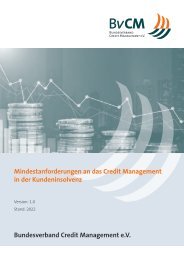Create successful ePaper yourself
Turn your PDF publications into a flip-book with our unique Google optimized e-Paper software.
Company Profile<br />
Second Quarter of 2019<br />
///////////<br />
As of June 30, 2019
2<br />
Die Bayer AG stellt sich vor!
Our Purpose: “Science for a better life”<br />
Bayer is a life science company<br />
and a global leader in health care<br />
and nutrition. Our innovative<br />
products support efforts to<br />
overcome the major challenges<br />
presented by a growing and aging<br />
global population. Guided by our<br />
corporate purpose “Bayer:<br />
Science for a better life,” we help<br />
to prevent, alleviate and treat<br />
diseases. We are also making an<br />
important contribution to<br />
providing a reliable supply of<br />
high-quality food, feed and<br />
plant-based raw materials, while<br />
at the same time promoting the<br />
sustainable use of natural<br />
resources. Our business activities<br />
therefore also support the<br />
attainment of the United<br />
Nations Sustainable<br />
Development Goals.<br />
3
Our Business Areas<br />
Crop Science<br />
Pharmaceuticals<br />
Consumer Health<br />
Innovative chemical & biological<br />
crop protection, seeds & traits,<br />
digital technologies & services<br />
Animal Health<br />
Prescription products for cardiology,<br />
women’s health care,<br />
oncology, hematology, ophthalmology,<br />
radiology and other areas<br />
Non-prescription medicines in the<br />
categories of dermatology, nutritional<br />
supplements, pain, cardiovascular risk<br />
prevention, digestive health, allergy,<br />
cough & cold and other areas<br />
4
Bayer Group Key Data<br />
Full-year sales<br />
€39.6 billion<br />
Investment in<br />
research<br />
& development<br />
€5.2 billion<br />
Employees<br />
115,498<br />
Countries<br />
90<br />
As of December 31, 2018; employees as of June 30, 2019, in full-time equivalents<br />
5
Bayer on track in operational business<br />
Second Quarter of 2019<br />
Group sales increase to €11.5 billion (Fx & portfolio adj.* +0.9%)<br />
EBITDA before special items advances to €2.9 billion (+24.7%)<br />
Crop Science sales decline (Fx & portfolio adj. and pro forma) in challenging environment;<br />
substantial earnings growth due to acquired business<br />
Pharmaceuticals p<strong>ost</strong>s higher sales and strong earnings growth<br />
Consumer Health increases sales and earnings<br />
Net income of €0.4 billion (–49.1%) held back by special items for restructuring and impairments<br />
Core earnings per share €1.62 (+5.9%)<br />
Group outlook confirmed yet ambitious<br />
* Fx & portfolio adj. = currency- and portfolio-adjusted<br />
6
Bayer Group Key Data<br />
Second Quarter of 2019<br />
€ million<br />
Q2<br />
2018<br />
Q2<br />
2019 Change %<br />
H1<br />
2018<br />
H1<br />
2019 Change %<br />
Full Year<br />
2018<br />
Sales 9,481 11,485 +21.1 (+0.9*) 18,619 24,500 +31.6 (+2.4*) 39,586<br />
EBITDA 2,031 2,486 +22.4 4,849 5,624 +16.0 10,266<br />
EBITDA before special items 2,348 2,927 +24.7 5,244 7,115 +35.7 9,547<br />
EBITDA margin before special items 24.8% 25.5% 28.2% 29.0% 24.1%<br />
EBIT 1,346 926 –31.2 3,656 2,876 –21.3 3,914<br />
EBIT before special items 1,708 1,785 +4.5 4,096 4,785 +16.8 6,480<br />
Financial result (323) (477) –47.7 (193) (793) • (1,596)<br />
Net income<br />
(from continuing and discontinued operations)<br />
Earnings per share (€)<br />
(from continuing and discontinued operations)<br />
Core earnings per share (€)<br />
(from continuing operations)<br />
Net cash provided by operating activities<br />
(from continuing and discontinued operations)<br />
794 404 –49.1 2,748 1,645 –40.1 1,695<br />
0.87 0.41 –52.9 3.05 1.68 –44.9 1.80<br />
1.53 1.62 +5.9 3.76 4.17 +10.9 5.94<br />
2,240 1,600 –28.6 2,898 2,679 –7.6 7,917<br />
Cash outflows for capital expenditures 459 458 –0.2 808 853 +5.6 2,593<br />
Research and development expenses 1,267 1,351 +6.6 2,307 2,707 +17.3 5,246<br />
Depreciation, amortization and impairments 685 1,560 +127.7 1,193 2,748 +130.3 6,352<br />
Number of employees** at end of period (as of June 30, 2019) 124,055 115,498 –6.9 124,055 115,498 –6.9 116,998<br />
7<br />
2018 figures restated * Year-on-year change currency- and portfolio-adjusted<br />
** Employees in full-time equivalents
Key Data Q2 2019<br />
Group by Segments in € Million<br />
Sales<br />
EBITDA before special items<br />
Other / Reconciliation<br />
379<br />
Animal<br />
Health<br />
454<br />
–2.7%*<br />
Consumer<br />
Health<br />
1,442<br />
+2.1%*<br />
3% 42%<br />
4%<br />
13%<br />
11,485<br />
38%<br />
Crop Science<br />
4,788<br />
–3.1%*<br />
1.600 1,600<br />
1.400 1,400<br />
1.200 1,200<br />
1.000 1,000<br />
800<br />
600<br />
400<br />
200<br />
1,075<br />
1,500<br />
270<br />
124<br />
Pharmaceuticals<br />
4,422<br />
+3.9%*<br />
0<br />
Crop<br />
Science<br />
+66.9%<br />
Pharmaceuticals<br />
+10.1%<br />
Consumer<br />
Health<br />
+5.5%<br />
Animal<br />
Health<br />
–3.1%<br />
* Year-on-year change currency- and portfolio-adjusted<br />
8
Credit, Collection &<br />
Dispute<br />
Management<br />
///////////<br />
August 2019
10<br />
Die Einführung von SAP Financial Supply Chain<br />
Management (FSCM) inklusive der Anwendung zur<br />
Vereinfachung des Credit Managements
Starting point AR & Credit Management<br />
Working Capital Initiative<br />
2008<br />
Initiative started with focus on WoC<br />
Receivable had to contribute<br />
2008-2019 Approach<br />
Receivable Action Items and<br />
Measures<br />
Challenges 2011<br />
Implementation Credit<br />
Management 2013<br />
Reduction of overdues<br />
Harmonization of Payment Terms<br />
Etablishment of Golden Rules<br />
AH/CH/PH- no central credit mgmt.<br />
No global community, no guideliness<br />
No standard process or system<br />
11 Legal Creidt Management<br />
Scorceard 1.0 for 170k Customer<br />
Increase of transparency (less ICS)<br />
What next? 2017<br />
Increase of community CS joined<br />
Need: Automation/Standard in B2C<br />
11
Four strategic pillars to enhance customer satisfaction and service efficiency<br />
Customer Focus<br />
Great Place to Work<br />
Innovation<br />
Value Realization<br />
12
Order to Cash Organization<br />
Definition<br />
Order-to-Cash (O2C) refers to the process from registering established commercial agreements, credit<br />
conditions, fulfilling a customer order and receiving payment including collection activities<br />
Scope<br />
Commercial<br />
agreement<br />
Customer<br />
master data<br />
management<br />
Credit<br />
management<br />
Order<br />
management<br />
Order<br />
fulfillment<br />
Billing<br />
Collections<br />
and disputes<br />
management<br />
Accounts<br />
receivables<br />
management<br />
Commercial<br />
agreement<br />
registration and<br />
transfer<br />
Setup customer<br />
accounts<br />
Customer risk<br />
assessment<br />
Manage<br />
sales<br />
orders<br />
Initiate country<br />
stock transfer<br />
Issue<br />
invoices<br />
Manage<br />
collections<br />
Customer account<br />
maint. and recon.<br />
Commercial<br />
agreement<br />
monitoring and<br />
care<br />
Validate and<br />
update customer<br />
data<br />
Credit limit<br />
management<br />
Manage<br />
complaints<br />
Initiate<br />
local<br />
delivery<br />
Manage customer<br />
rebates /<br />
incentives<br />
Manage disputes<br />
Manage remittance<br />
advice<br />
Regular financial<br />
statement monitoring<br />
Manage<br />
returns<br />
Customer delivery<br />
confirmation<br />
(track and trace)<br />
Manage customer<br />
debit / credit<br />
memos<br />
Cash allocation<br />
Credit<br />
insurance<br />
management<br />
Value adjustments<br />
Period end activities<br />
incl. Audits<br />
13
WHAT<br />
…will change?<br />
You will have:<br />
Simplified customer credit<br />
approach<br />
Integrated workflows with email<br />
approval<br />
Higher automation and full Internal<br />
transparency for credit and<br />
collaterals<br />
…are the benefits?<br />
You will benefit from:<br />
Automation and rule based credit<br />
decision<br />
Faster internal business alignment<br />
and automatic internal<br />
documentation<br />
Improve customer experience via<br />
faster decisions<br />
…will stay the same?<br />
Unchanged for you:<br />
Local flexibility based to define<br />
commercial policies on the<br />
Global Guidance and Policy<br />
Support of different business<br />
strategies focusing at the same<br />
time on customer needs<br />
Provide credit limit assessment<br />
& assess credit and business<br />
risks
FSCM Big Bang – Credit Management<br />
Transformation Overview & Scope<br />
Overview<br />
FSCM (Financial Supply Chain Management) – implemented in all PBC & P2R countries<br />
FSCM is a solution to manage highly automated the order-to-cash cycle which involves evaluating the customer credit,<br />
resolving billing disputes, collecting overdue accounts to ensure timely receipt of payments, as well as a healthy<br />
operating cash flow.<br />
Project scope: enhancement of existing FSCM Credit and Collateral Management Module<br />
IT infrastructure<br />
SAP FSCM<br />
Credit Management<br />
Enhancements<br />
Process Level 1 Process Level 2 Main New Functionality<br />
Credit Management<br />
Customer risk<br />
assessment<br />
Credit limit<br />
management<br />
Risk Class Change Approval – requests and approvals in SAP<br />
Integration of customer financials (semi-automatic)<br />
Credit limit Request (CLR) and Risk Class Request (RCR)<br />
functionality to approve or reject decisions<br />
Documented Credit Decision (DCD) functionality to approve or<br />
reject release of credit blocks<br />
Improved Business Partner management using Global, Regional<br />
and Local Responsibility Level<br />
Credit integration of Collateral Management (Guarantees, Barter, ..)<br />
15
20 Healthcare<br />
Big Bang - Credit<br />
Management Scope<br />
25 Countries<br />
18 Crop science<br />
34 Healthcare<br />
55 Legal<br />
Entities<br />
21 Crop science<br />
Scope
FSCM Big Bang – Credit Management<br />
Overview of training materials<br />
Process Maps<br />
1. Customer risk assessment – Link (myBPM)<br />
2. Credit limit management – Link (myBPM)<br />
Desktop procedures – make sure you are already logged in BEAM before accessing the below links<br />
1. Customer risk assessment – Link (BEAM)<br />
1.1 Business Partner Hierarchy View & Maintenance – Link (BEAM)<br />
2. Credit limit management – Link (BEAM)<br />
2.1 Collaterals – Link (BEAM)<br />
Training materials<br />
1. Overview Credit Management - Link<br />
2. BP responsibility – Link<br />
3. Risk Class Request – Link<br />
4. Credit Limit Request – Link<br />
5. Documented Credit Decision – Link<br />
Draft – Detailed materials<br />
1. Risk Class Request – Link<br />
2. Credit Limit Request – Link<br />
3. Collaterals – Link<br />
Ask Videos<br />
1. BP responsibility – Link<br />
2. Risk Class Request – Link Video 1 / Link Video 2<br />
3. Credit Limit Request – Link<br />
4. Documented Credit Decision – Link<br />
5. Collaterals & FD document – Link
FSCM Big Bang<br />
Transformation Plan – focus on UAT (Regional – CS & HC together)<br />
1 LATM - April 16 th – 20 th 2018<br />
NA - April 23 rd – 27 th 2018 2<br />
Country LE<br />
Country LE<br />
Brazil 1353<br />
Colombia 1321<br />
Mexico 168<br />
1<br />
5<br />
4<br />
EMEA 2 - May 22 th – May 25 th 2018<br />
Country LE<br />
Germany 32 Germany 2001<br />
Germany 1230 Finland 2174<br />
Germany 1341 Netherlands 1901<br />
Germany 1546 Switzerland 1611<br />
Germany 1582 UAE 1707<br />
EMEA 1 - May 16 th – May 18 th 2018<br />
Country LE<br />
Belgium 1340<br />
Belgium 159<br />
France 190<br />
France 193<br />
France 1269<br />
Germany 932<br />
Germany 2030<br />
Italy 185<br />
Italy 948<br />
Italy 1345<br />
Ireland 184<br />
Netherlands 188<br />
Portugal 193<br />
Portugal 1334<br />
Spain 267<br />
Spain 1254<br />
Spain 2138<br />
Turkey (HC) 92<br />
Turkey (CS) 92<br />
UK 203<br />
UK 1315<br />
5<br />
LATM<br />
Sao Paolo (Brazil)<br />
4<br />
UAT<br />
EMEA 1<br />
Loos (France)<br />
3<br />
Mumbai (India)<br />
2<br />
Canada 393<br />
Canada 1318<br />
C<strong>ost</strong>a Rica 1914<br />
US 353<br />
US 1372<br />
US 2083<br />
APAC - May 7 th – May 11 th 2018<br />
Country LE<br />
Australia 157<br />
Australia 1335<br />
China 882<br />
China 1391<br />
China 1953<br />
China 1954<br />
China 1955<br />
Korea 695<br />
Korea 963<br />
India 73<br />
India 1332<br />
Japan 94<br />
Japan 134<br />
Philippines 1508<br />
3<br />
18
Overview Credit Management Processes<br />
Global view<br />
Master Data Maintenance<br />
Credit Profile<br />
Global Financial Data<br />
Credit Segment<br />
Relationships<br />
Credit Limit<br />
Key Figures<br />
Collaterals Management<br />
Credit Check<br />
Cockpit<br />
Score<br />
Risk Class<br />
19
Global Credit Manager View – one click all information<br />
Page 20
Master Data Maintenance - Credit Profile<br />
• Clear view of<br />
• Credit Check Account<br />
• Customer Group<br />
• Responsibility Levels (Local, Regional,<br />
Global)<br />
• Other information on “Credit Profile”:<br />
• Risk-Automode<br />
• Risk Class Change Documents
Master Data Maintenance - Credit Segment<br />
• Replication from Master Data System<br />
• Credit Segments (derived from activated company codes)<br />
• Soft Block (derived from classification ‘Out of Business’)<br />
• Defaulting when BP is created<br />
• Credit Limit<br />
• Soft Block<br />
• Special Attention Types<br />
• Other Information on “Credit Segment”:<br />
• Credit Limit Automode<br />
• Seasonal Credit Limit<br />
• Growth Factor<br />
• Block Reasons<br />
• Check override<br />
• Collaterals
Master Data Maintenance - Global Financial Data<br />
• Create / Change / Delete Global Financial Data<br />
• Two different Statement Types: Annual / Quarterly<br />
• Maintenance<br />
• Manual<br />
• Excel Mass Upload (Report: /BAY0/FM_CR_UPL_FIN)<br />
• Must be balanced<br />
• Balance Sheet Information<br />
• Income Statement<br />
• Ratios<br />
• Delta Y o Y (compare 1 st column with 2 nd )<br />
• 3 Yr Trend (compare 1 st column with 3 rd column)<br />
• Additional Data (all used for score calculation)<br />
• Country Risk<br />
• Outlook<br />
• Starting Year<br />
• 3rd Party Data
Score – Calculation and Snapshot<br />
• If 3 rd Party Data” is not available, its<br />
weight will be equally distributed<br />
among these four parameters:<br />
• Weighted Average Days Late (=ADD 12<br />
Months Average)<br />
• Delta WADL year over year (=ADD Delta 12-<br />
24)<br />
• Years in Business (=Starting year)<br />
• Country Rating (=Bayer country rating)<br />
• Score validity date is determined in dependence of credit<br />
limit and risk class (BRF+ decision table).<br />
• The Snapshot (which contains details of score calculation,<br />
score history, financial statement information, ratios,<br />
balance sheet analyses etc.) can be displayed via the<br />
information button next to the score.<br />
• Value -999 is displayed in Snapshot if the parameter is not<br />
available.
Risk Class – Calculation and Automatic Mode<br />
• Children inherit risk class value from<br />
GU.<br />
• Risk class can change<br />
• if score value changes<br />
• if a new risk class is manually requested and<br />
approved (Risk Class Request).<br />
• Only credit analyst or members of<br />
credit analyst group assigned to that<br />
BP are allowed to set flag<br />
“Automatic Mode”.<br />
• If “Automatic Mode” is flagged, a<br />
risk class request (RCR) is created<br />
and automatically approved.<br />
• If “Automatic Mode” is not flagged, a<br />
RCR is created and needs to be<br />
processed manually.
Risk Class – Risk Class Request (RCR)<br />
• Risk Class Requests can be created manually via the button in<br />
the Business Partner (tab “Credit Profile”).<br />
• The latest Risk Class Request can also be displayed via a<br />
button in the BP (tab “Credit Profile”).<br />
• If there are several credit analyst<br />
groups with the same responsibility<br />
level, the group of the segment with<br />
the highest credit limit is assigned to<br />
the RCR.<br />
• Emails are not sent out during the risk<br />
class approval process.
Credit Limit - Automatic Mode<br />
• Only credit analyst or members of credit<br />
analyst group assigned to that BP are<br />
allowed to set flag “Automatic Mode”.<br />
• If “Automatic Mode” is flagged, the<br />
calculated limit does not result in a CLR<br />
(=does not need to be approved).
Credit Limit - Credit Limit Request (CLR)<br />
• If responsibility level is GLO or REG, limit can only be<br />
manually requested on main segment. If it is LOC, the limit<br />
can only manually be requested on credit segment level.<br />
• Manual requests do always lead to the creation of a CLR.<br />
• Requester must be credit analyst or member of credit<br />
analyst group.<br />
• Approver must be member of approver group (to be<br />
maintained in BP master data relationships).<br />
• Approver groups must be maintained in BRF+ table (in<br />
dependence of responsibility level, credit segment,<br />
requested limit and relative change).
Key Figures – ADD/ADP & High Balance<br />
• ADD, ADP and High Balance key figures are consolidated on GU level and main segment level.<br />
• All available credit segments of the children must have been created for the GU. If not, the consolidation<br />
of these key figures fails.<br />
• Key figures on tab “Payment Behaviour Key Figures” (e.g. “highest dunning level”, “oldest open item”)<br />
are not consolidated.
Credit Check – Documented Credit Decisions (DCD)<br />
• For each blocked order, a DCD is created.<br />
• Approver of DCD must be member of approver group (to be maintained in BP master data relationships).<br />
• Credit Analyst Groups must be maintained in BRF+ table (in dependence of credit segment, risk class, order<br />
value).<br />
• Approver groups must be maintained in BRF+ table (in dependence of credit segment, risk class and order<br />
value).
Cockpit<br />
• Transaction /BAY0/FM_CR_COCKPIT<br />
• After having entered any selection criteria, the report has to be executed (F8) via the above<br />
highlighted button.
Key learning<br />
Credit<br />
Changing concept of the customer hierarchies before the go live<br />
Working with 6 key countries (US; FR; IN; IT; DE, KR) to create the blueprint<br />
Documentation of the processes<br />
Refresh traning before the go live<br />
Longer Hypercare phase and FAQ creation<br />
No Waterfall development -> agile methodology<br />
Big Bang approch, right decission!<br />
Downgrade the ICS controls to business process controls<br />
Automation is key with a growing business<br />
32
Next steps<br />
Scorecard 2.0 for more automation and risk mitigation<br />
33
Contact<br />
Zahre Cinibulak<br />
Global Process Owner Credit, Collections & Dispute Management<br />
Phone:<br />
Mobile:<br />
e-mail:<br />
+49 – 214 30-52087<br />
+49 – 173 56-52487<br />
Zahre.Cinibulak@<strong>bayer</strong>.com<br />
34


















